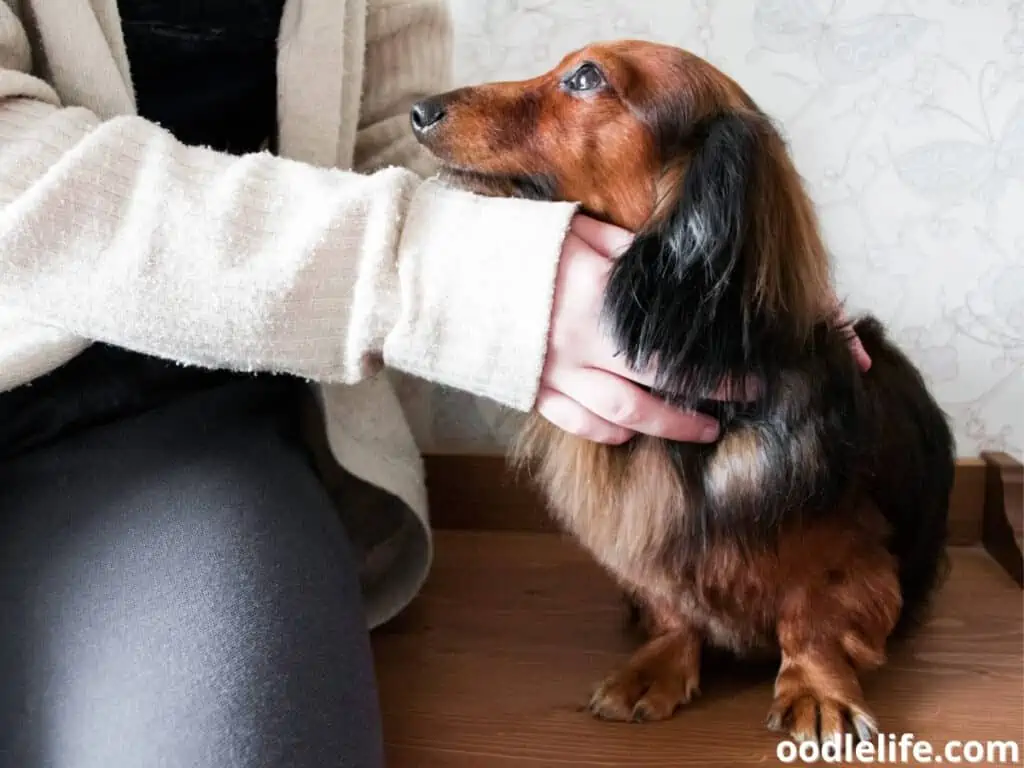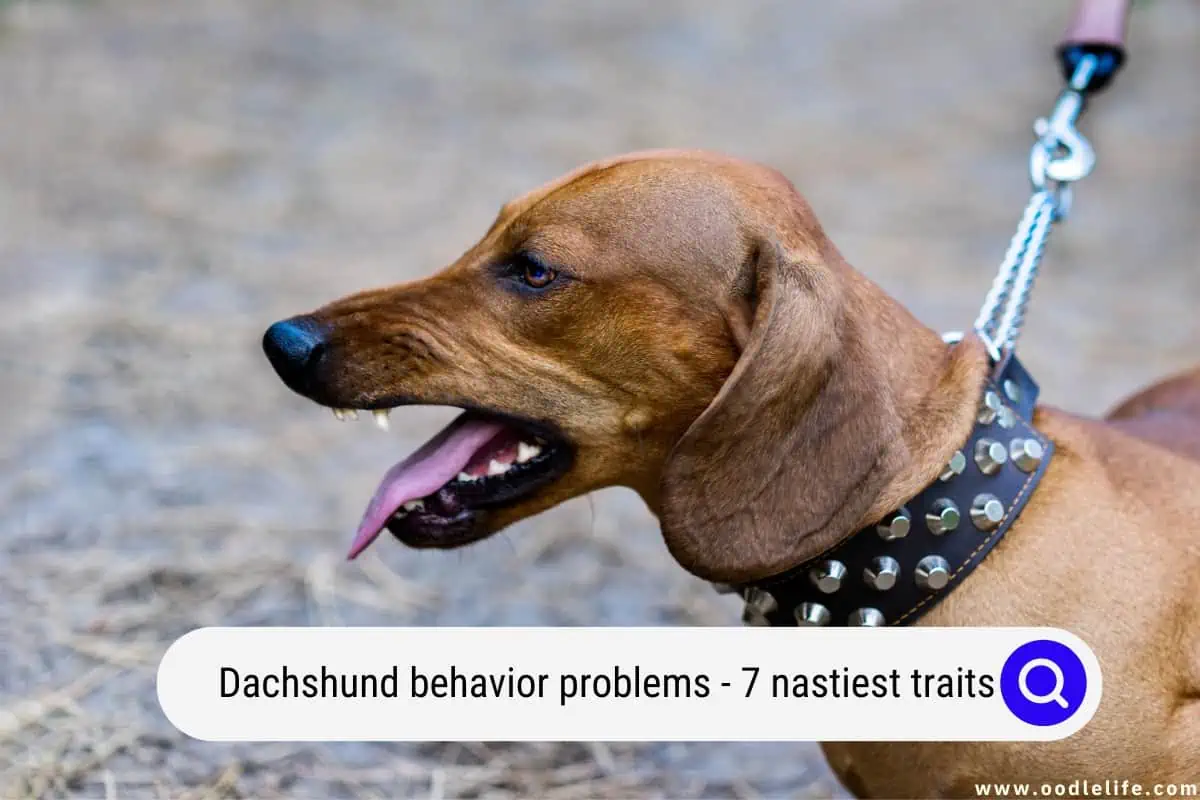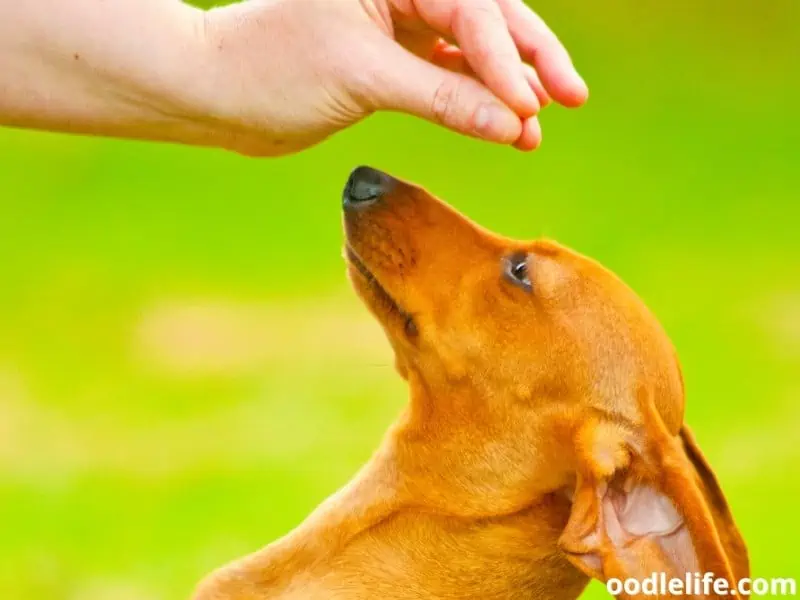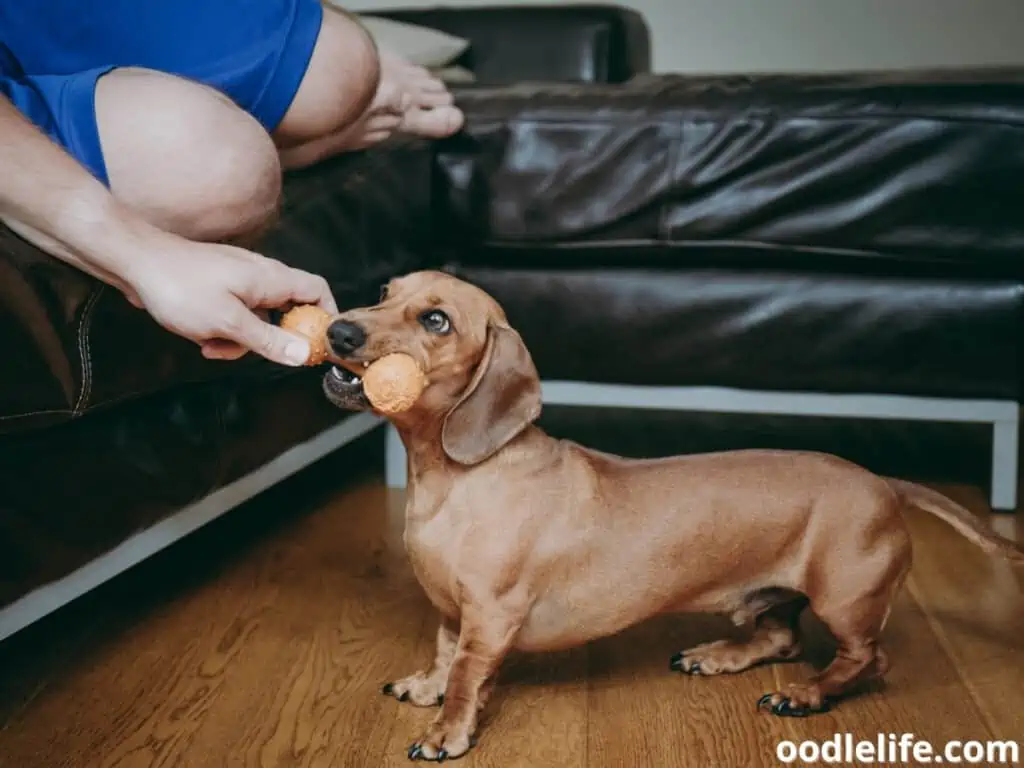7 Must-See Reasons Why a Dachshund is Whining So Much
Dachshunds, affectionately known as “wiener dogs,” are lovable little dogs with a lot of personality. However, they may exhibit some fairly common behaviors that could be puzzling, and one such behavior is whining. Our furry friends cannot tell us what’s bothering them, so understanding why your Dachshund is whining is important to maintaining a healthy and happy relationship with them.
There are several possible reasons for a Dachshund’s whining, and it’s essential to determine the root cause of this behavior. It could spring from anxiety, boredom, hunger, pain, or simply seeking attention.

By observing your pet and paying attention to the circumstances in which the whining occurs, you will better understand your Dachshund’s specific needs and emotional language.
Key Takeaways
- Identify the root cause of your Dachshund’s whining behavior.
- Observe and analyze the circumstances to better understand their emotional language.
- Prioritize their health and well-being to resolve the issue effectively.
Common Reasons for Dachshund Whining
Seeking Attention
Dachshunds are known for being lively and intelligent dogs, so it’s no surprise that they crave attention from their humans. Sometimes, a little whining might be their way of asking for some interaction. Maybe they want a tasty treat, a fun toy, or just a good old-fashioned cuddle session.

So, if your Dachshund is whining, try giving her some attention, but also remember not to reinforce the whining behavior – let her know what you expect by rewarding her when she’s quiet.
Fear and Anxiety
Dachshunds can become anxious or fearful in certain situations, such as loud noises like fireworks or thunderstorms, or when they’re left alone for long periods (hello, separation anxiety). Whining can be an expression of their stress and worry. If you notice your Dachshund whining in response to a specific trigger, try providing some comfort and reassurance.

You might also want to consider crate training or introducing a calming toy, like a snuggle buddy, for your frightened furry friend.
Pain and Health Issues
Feeling under the weather isn’t fun for anyone – even for Dachshunds. If your little sausage dog is whining more than usual, it might be a sign that they’re experiencing pain or discomfort. Common health issues that could plague your Dachshund include back problems, joint issues, or dental pain.

Before you go thinking your dog is just being melodramatic, make a trip to the vet to rule out any physical cause for their pained vocal serenade.
Boredom and Loneliness
Dachshunds are active dogs with a natural instinct to burrow and dig. If they don’t get enough mental stimulation or opportunities to burn off that wiener dog energy, they might express their boredom and loneliness with a rather melodious whine. To combat this, try incorporating regular walks, engaging toys, and interactive playtime into your Dachshund’s daily routine.

Socializing with other dogs, cats, or even humans (other than their doting family members) can also help your little digger feel more connected to the world around them.
In summary, your Dachshund might be whining for several reasons, ranging from wanting attention to expressing anxiety, pain, or boredom. Identifying the cause and addressing it is the key to keeping your Dachshund’s whining to a minimum while ensuring their happiness and well-being. Just be thankful they can’t actually say, “Are we there yet?” on long road trips!
Understanding Dachshund Communication

Whining vs Barking vs Howling
Dachshunds, like other dogs, have their own unique ways of expressing themselves. They might whine, bark, or howl, depending on their mood and the message they want to convey. For example, a Dachshund may whine when feeling anxious, wanting attention, or experiencing discomfort.
On the other hand, barking usually occurs when they feel threatened, need to alert their owner, or just want to be heard. Finally, howling serves as a form of long-distance communication, often to find and connect with other dogs. It’s important to recognize these differences to provide your Dachshund the care and attention they need.
Body Language and Signals
Apart from vocalizations, Dachshunds also use body language to communicate. Here are a few key signals to watch out for:
- Tail: A wagging tail often signals happiness, but how it wags can be significant. A slow wag could mean cautiousness, while rapid wags communicate excitement. Conversely, a tucked tail represents fear or submission.
- Ears: Alert ears indicate curiosity or interest, while flattened ears might mean your Dachshund is scared or feeling submissive.
- Posture: A relaxed and balanced posture is a good sign, whereas a stiff, tense posture could indicate aggression or anxiety.
- Pacing: If your Dachshund is pacing back and forth, they might be stressed, bored, or need some exercise to burn off energy.
Understanding these signals can help you better address your Dachshund’s emotions and needs, providing a nurturing environment for your beloved pet. So next time your little wiener dog starts pacing around the house or whining incessantly, you’ll be better equipped to decipher their mysterious, sausage-shaped language!
Addressing the Whining Behavior

Identifying Underlying Causes
Before diving into training techniques, it’s essential to identify the underlying causes of your Dachshund’s whining. Common causes can include hunger, stress, a need for exercise, or even a change in their environment. For example, if your pup is whining because they’re hungry, it’s like they’d appreciate a quick snack rather than a training session.
Similarly, if they’re whining due to a lack of exercise, a brisk walk can help alleviate their boredom and restless energy.
Training Techniques
If the underlying cause has been addressed and your Dachshund continues to whine, it’s time to introduce some training techniques. One method to use is command training, where you’ll teach your dog to be quiet on cue. To start, wait for your pup to whine and then give the command “quiet.”
The moment they stop whining, praise them and give a treat as a reward. With consistent practice, your Dachshund will learn to associate the command with being silent.
Another training technique is desensitization, which can help your dog overcome any fears or anxieties that may be causing their whining. For example, if their whining is triggered by a specific noise, such as the vacuum cleaner, gradually expose them to the sound while rewarding and praising calmer behaviors. Over time, they’ll learn that the sound is nothing to be afraid of.
Positive Reinforcement
Perhaps the most important aspect of addressing your Dachshund’s whining behavior is the use of positive reinforcement. When training, be sure to reward and praise your dog for good behavior. This can be as simple as offering a treat or engaging in play whenever they remain quiet and calm.
By focusing on rewarding positive behaviors, you’re less likely to accidentally reinforce undesirable habits, such as whining for attention.
Keep in mind that Dachshunds can be a bit stubborn at times, so patience and consistency are key. Remember to celebrate small victories and keep a sense of humor as you work together to address whining behaviors. With time and effort, your Dachshund will become more adept at understanding your expectations and showing off their quiet, well-behaved side!
Ensuring Health and Well-being
Regular Veterinary Visits
Regular veterinary visits play a vital role in your Dachshund’s health and well-being. These check-ups can help identify potential health problems, such as joint pain or arthritis, which could make your pup uncomfortable and cause excessive whining. By scheduling regular visits with the vet, you’re not only staying proactive about your pup’s health but also ensuring they’re as comfortable and happy as possible.

Remember, a happy and healthy Dachshund is a less whiny one!
Physical Activity and Exercise
Dachshunds, like their wolf ancestors, require physical activity and exercise to stay healthy and mentally stimulated. Incorporating daily walks and engaging in fun outdoor games can help alleviate your Dachshund’s whining. Exercise can also reduce the risk of health issues like joint pain and arthritis, which are common in this breed due to their long back and short legs.

Be aware not to overexert them, as moderation is key to maintaining strength and fitness—plus, nobody enjoys a tired and grumpy Dachshund.
Mental Stimulation
Mental stimulation is crucial for keeping your Dachshund happy and whine-free. Interactive dog toys and puzzle feeders are great options to keep their brains working and provide much-needed mental enrichment. A mentally stimulated pup tends to whine less and have a more balanced demeanor.

Just think of it like a Sudoku puzzle for your dog—they’ll be focused and less prone to vocalize their frustrations.
Socialization
Socializing your Dachshund is another way to decrease their whining. Exposure to various environments, people, and other dogs can help them become more relaxed and confident. Proper socialization reduces anxiety and stress, which, in turn, reduces whining—because a well-socialized Dachshund is like a social butterfly, minus the wings and the antennae, of course.

Remember, the more they experience, the less they’ll feel the need to serenade you with their whining.
Caring for an Anxious or Scared Dachshund
Coping with Fear and Anxiety Triggers
Dachshunds, like many other dog breeds, may experience fear and anxiety from various triggers. One classic example is the apprehension caused by thunderstorms, which can make Dachshunds cry or whine. To alleviate their distress, try to distract them with their favorite toy or offer treats as positive reinforcement for calm behavior.

A soothing toy or piece of your clothing that smells like you may provide additional comfort.
Sometimes, dental problems can cause discomfort and lead to persistent whining. Regular teeth cleaning and veterinary checks can help identify and address any underlying dental issues before they escalate.
Creating a Comfortable Environment
A comfortable and secure environment can help your Dachshund feel more at ease. Make sure their bed or resting area is in a quiet and cozy corner, away from drafty windows or other loud disturbances. This can be especially crucial during dark, ominous evenings when your Dachshund may feel more vulnerable.

To help your Dachshund deal with frustration, provide them with mental and physical stimulation through daily walks, puzzle toys, and regular playtime. A well-exercised Dachshund is less likely to feel pent-up frustration and resort to whining.
Remember, patience and understanding are key when dealing with a scared or anxious Dachshund. By identifying their triggers and implementing these coping strategies, you can help your furry friend live a happier, more peaceful life.
Frequently Asked Questions
What causes excessive whining in Dachshunds?
Dachshunds, like all dogs, may whine for various reasons. Some common causes could include anxiety, fear, boredom, or attention-seeking behavior. Additionally, Dachshunds might be more prone to separation anxiety and stress due to their strong bonds with their owners.
How can I reduce my Dachshund’s anxiety and whining?
To reduce your Dachshund’s anxiety and whining, try to identify possible triggers and address them accordingly. For example, if your dog is anxious when you leave, gradually increase the time you spend apart to help your Dachshund adjust. Providing mental and physical stimulation through exercise, playtime, and puzzle toys can also help alleviate anxiety and boredom.
What are the common reasons for a Dachshund to whine constantly?
A Dachshund might whine constantly due to emotional or physical needs. Emotional reasons could be anxiety, fear, or attention-seeking behavior, while physical needs might include hunger, needing to go outside, or feeling discomfort.
How to address attention-seeking behavior in Dachshunds?
To address attention-seeking behavior in Dachshunds, avoid inadvertently reinforcing the whining by giving attention, treats, or access to something they want. Instead, reward your dog when they are quiet and calm, and teach them alternative ways to gain your attention, like sitting or performing a simple trick.
Is whining a sign of pain or discomfort in Dachshunds?
While whining does not always indicate pain or discomfort, it could be a sign that something is bothering your Dachshund. If the whining persists or is accompanied by other symptoms (e.g., limping, loss of appetite, or changes in behavior), consult your veterinarian to rule out any medical issues.
What are effective ways to manage night-time whining in Dachshunds?
Night-time whining in Dachshunds can be managed with a consistent routine, adequate exercise and mental stimulation during the day, and creating a comfortable sleep environment. Ensure your Dachshund’s bed is comfortable, the room is dark, and the temperature is appropriate. Using white noise or soft music might help your dog relax.
If your Dachshund continues to whine at night, consult a professional for additional guidance.